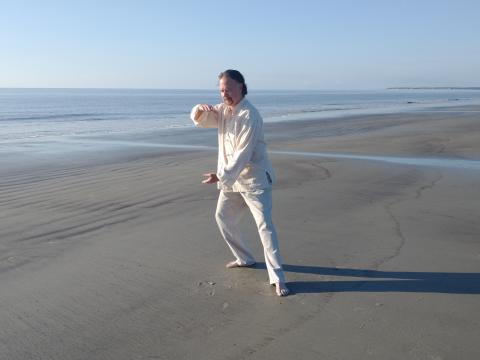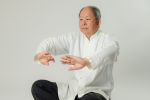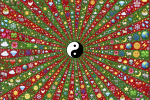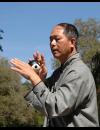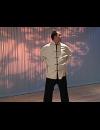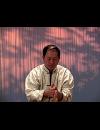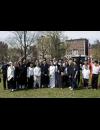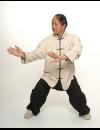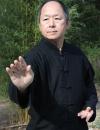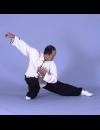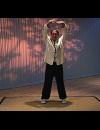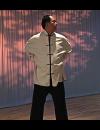Tai Chi and Qigong for Arthritis and Pain
June 3, 2024
Hypoxia, which is an oxygen deficiency in the tissues, underlies or complicates almost every health condition. This is the reason I have proposed the term Metarobic exercise to describe the effects of Tai Chi and related exercises on the body. 9 Min Read
Theory of Taijiquan and Health
May 20, 2024
Though the martial side of Tàijíquán is for strengthening the physical body and for defense, the scholarly side of Tàijíquán is for understanding human nature and comprehending the meaning of life. Only if (you) can cultivate these, both internally and externally, can you reach the Dào of balancing physical body and mind, and (also) the dual cultivation of human nature and physical body.
8 Min Read
The Power of Mass Tai Chi Recitals
April 29, 2024
In honor of World Tai Chi & Qigong Day 2024, YMAA Staff Writer Gene Ching examines tai chi demonstrations done in large groups. 6 Min Read
Five Regulators of Taijiquan
April 8, 2024
What is Tàijíquán? It is a martial Qìgōng study. Its training procedures are not different from those of other general Qìgōng (practice) and must follow the (same training) theory. These training procedures are nothing else but: regulating the body, regulating the breathing, regulating the mind, regulating the Qì, and regulating the spirit—five regulatings.
7 Min Read
Yin-Yang Theory of Movement and Stillness in Taijiquan
January 22, 2024
If you are able to understand the theory of calmness, then you can comprehend the applications of Jìng (i.e., martial power).
Reading Time 6 minutes
About Pushing Hands—Part 1
-
March 23, 2015
Practicing Methods of the Four Directions and Four Corners (Eight Doors, Eight Trigrams). What are the four directions and four corners? They are the eight doors. It is also the theory of Eight Trigrams in Taijiquan. What are the four directions?
Basic Taiji Theory
-
March 16, 2015
If we desire to understand taiji theory, then we must first trace back to its origins and roots. Only then will we know how and where it came from. Although a great proportion of Chinese martial arts history is vague, we can still trace it with some accuracy and in some detail.
Four Applications of Taiji Ball Qigong (太極球氣功之應用)
-
December 15, 2014
At this stage, you should be able to practice the circling, rotation, and wrap-coiling patterns smoothly. You should also be able to perform each of these patterns comfortably while stationary, rocking, stepping, and bagua stepping.
What is Qin Na?
-
November 17, 2014
Taijiquan (太極拳) was originally developed for combat in ancient times. Its fighting theory is to use the soft against the hard, and to use the round to neutralize the straight or square. In order to achieve this goal, the body must be soft and the movements must be smooth and natural. Taijiquan also emphasizes the cultivation of qi (氣), or internal energy.
Stress and Health
-
November 10, 2014
We live with different life styles, have different personalities, have different occupations, and come from different cultures. We are all different, but we can also be happy with who we are, what we do, how much we have, and with whom we associate with.
The Sword Way
-
October 20, 2014
In ancient China, the way of the sword was widely respected. This was so not just because sword techniques and skills were difficult to learn. The main reason was that moral and spiritual qualities were required in order to attain the highest levels of its art.
Natural Healing for Depression
-
September 23, 2014
It was heart-breaking news to hear that we lost one of our favorite entertainers, Robin Williams. Thankfully his humor will stay with us forever. After learning how he passed, I wanted to address the danger of depression and offer some healing guidance.
Improving Quality of Qi's Manifestation
-
July 21, 2014
Here we will discuss how the quality of qi's circulation or manifestation can be improved. First, we should recognize that from Chinese martial art history, it was not until the fifth century that Chinese internal styles were developed, recognized, and practiced.
Qigong for Strengthening and Massaging the Internal Organs
-
June 9, 2014
Your internal organs are the foundation of your health. Most deaths are due to the malfunction or failure of the internal organs. In order to be healthy and avoid degeneration, your organs need to have the correct amount of Qi circulating smoothly through them.
Qigong for Arthritis
-
May 19, 2014
In the United States, May is “National Arthritis Awareness Month.” There are two major types of arthritis. According to the Arthritis Foundation, osteoarthritis or degenerative arthritis, which is the most common chronic condition of the joints affecting approximately 27 million older Americans. Rheumatoid arthritis (RA) is a disease of the immune system and attacks the synovium (a thin membrane that lines the joints) causing inflammation and pain. (RA) affects approximately 1.5 million Americans.
Guidelines for Taijiquan Practice
-
May 12, 2014
To successfully learn taijiquan (tai chi chuan), you will need to understand some of the principles and guidelines that have accumulated over the centuries by masters of this ancient art. These principles and guidelines are the foundation of taijiquan.
Historical Survey of Chinese Martial Arts - Part 2
-
May 7, 2014
During the Song dynasty (A.D. 960-1278) the monks of the Shaolin Temple continued to gather more martial skills from outside sources. They blended these arts into the Shaolin training. During this period, one of the most famous Shaolin martial monks, Jueyuan, traveled around the country in order to learn and absorb high levels of martial skill into Shaolin training.
Historical Survey of Chinese Martial Arts - Part 1
-
April 30, 2014
Chinese martial arts probably started long before history was recorded. Martial techniques were discovered or created during the long epoch of continuous conflict between humans and animals or between different tribes of humans themselves. From these battles, experiences were accumulated and techniques discovered that were passed down from generation to generation.
World Tai Chi and Qigong Day April 26, 2014
-
April 23, 2014
Celebrate World Tai Chi & Qigong Day (WTC&Q Day) on Saturday, April 26 at 10 a.m. all over the world. Beginning in New Zealand, this event will spread time zone by time zone across the globe, and will include hundreds of cities spanning 80 countries. Massive tai chi and qigong exhibitions will be held in public places such as parks, community centers, and tai chi schools across six continents. It's a time for people to come together, to breathe together, providing a healing vision for our world.
Traditional Yang Style Taijiquan
-
April 7, 2014
How Many Techniques in Taijiquan? In the traditional bare hand sequence, the apparent number of techniques vary between 81 and 150, depending on the method used to count and group the forms. Some instructors and writers, for example, will not count repeated forms. But basically, you may judge whether a taijiquan sequence is complete by comparing the arrangement of the names given to the techniques.
What are the Possible Types of Back Pain?
-
March 24, 2014
Back pain can be caused by an overstretching or other trauma to the back muscles and/or tendons. A tearing or inflammation of the ligaments in the spine can also cause back Pain. However, the most common and serious cause of back pain is spasm of the muscles in the lower back area brought on by spinal disease, injury or degeneration.
Empty and Full Moon Breathing Exercise for Abdominal Muscles
-
March 17, 2014
For this exercise, we will focus on the physical muscles surrounding the lower energy center area. This skill, coordinating the movement of the abdominal and back muscles with the movement of the lungs and diaphragm, should be practiced and emphasized on its own. This exercise is one of those pillar principles that should eventually be incorporated into every mind/body prescription throughout the Sunset Tai Chi program. It is ultimately used with every breath you take.
Fundamental Eight Stances (Ji Ben Ba Shi)
-
February 24, 2014
Before you practice traditional Yang Style Taijiquan, you should first learn some important fundamental practices. These practices will help you understand the essence and the root of taijiquan practice.
The Standing Brocades Qigong: Exercises 6, 7, and 8
-
November 24, 2013
The kidneys, which are beneath the two major back muscles, are the residence of original jing (yuan jing). When the kidneys are healthy and strong, your original jing is retained and strengthened. Only when your kidneys are strong will they be able to generate original qi (yuan qi) and enliven your body.
The Standing Brocades Qigong: Exercises 4 and 5
-
November 18, 2013
Five weaknesses refer to illnesses of the five yin organs: heart, liver, spleen, lungs, and kidneys. The seven injuries refer to injuries caused by the seven emotions: happiness, anger, sorrow, joy, love, hate, and desire.
